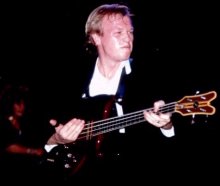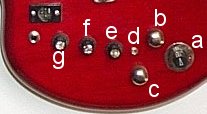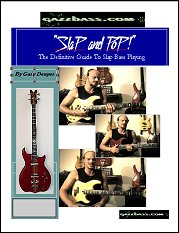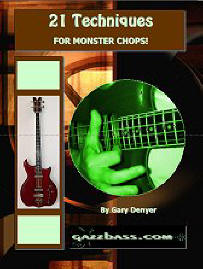
|
 |
|

Guitar Center Now Ships
Internationally
to over 90 countries! |
|
 |
|
 |
|
 |
|
|

|
|
|
7/1/2011 11:00:00 PM
|
|
Getting The Tone #1 - The Mark King Sound
|
| |
Introduction
Well, I'll always remember the time when I first started playing bass (I switched from normal electric guitar), and the television was on. It was the "Montreaux Pop Festival" of 1982. They had announced that two of my favorite bands, U2 and Level 42 (what a contrast!) were going to be on. So, I put down my $75 "Kay" bass with tape wound strings and began to watch.
 U2 played "Gloria", and I watched Adam Clayton play his infamous slap solo towards the end of the song. "Hmmm... that's a good sound", I thought. Then along came Level 42. They played "Almost There". I had the "Level 42" album in my collection, but the bass didn't sound the same as this! The sound Mark King got from this huge cherry red beast slung around his shoulders was, well, both unique and amazing for the time. "That's It!", I thought. Thus began my investigation to determine how that sound was produced.
U2 played "Gloria", and I watched Adam Clayton play his infamous slap solo towards the end of the song. "Hmmm... that's a good sound", I thought. Then along came Level 42. They played "Almost There". I had the "Level 42" album in my collection, but the bass didn't sound the same as this! The sound Mark King got from this huge cherry red beast slung around his shoulders was, well, both unique and amazing for the time. "That's It!", I thought. Thus began my investigation to determine how that sound was produced.
"Do I Need A JayDee?"
I gathered as much information as I could with regards to strings, equipment, guitars, amplifiers and FX that I could. Three or four years went by. Then, around 1987 or so, I bought a copy of the "Level 42 Live At Wembley" video. Mark had further refined his sound. It was unmistakably "that sound" but there was much more richness to it. I had, by then, discovered a lot about musical instrument sound dynamics with regards to strings, active circuitry and FX, and my tape wound strings and "Kay" bass were in the trash can years ago.
"Do I need a JayDee bass?", I found myself saying in a champagne taste with beer-bucket budget sort of way. Surely I can approximate this sound with my Fender Squier? Well... it wasn't that simple, but I was getting closer. And get this: The closer I came to achieving my favorite bass sound, the better I became as a player! (the subject for another article on psychology).
In 1989, I really splashed out and bought a Status Series II (I was happy, but my wallet was really thin for a while). "Wow", I exclaimed. The sound was like the "True Colours" LP sound. I tried various FX like chorus, reverb and compression. I also changed my strings to RotoSounds "30 - 90 piano wound design" strings...
It seems that to approximate this sound, it was more of a setup and FX thing rather than owning a JayDee, although with the JayDee, you can get the exact sound, obviously. Here's what I've found in the last 12 years or so. It can be applied to any guitar and any decent amp that has at least a seven band EQ on it.
Guitar And Amp Setup And Control Settings
The JayDee is a monstrous, yet wonderful beast (check out my review here). I will deal with the JayDee setup, although you can take these settings and apply it to your model of bass. These settings are very important to getting the sound that Mark King had on the "Live At Wembley" video release.
First up... strings. DO NOT buy tape or half round stings, unless you want to sound like a double bass! Extra-light gauge strings are what we want. Insist on one of these makes:
DR Strings
Elites
Rotosound
Status Hotwires
The gauge of the strings for a four-stringed instrument should be 0.030", 0.050", 0.070" and 0.090" or in bass jargon, 30's - 90's. Also remember to buy them in a scale that fits your bass! (i.e. 34" scale basses should buy long scale strings, etc.). I have found that a lot of music stores don't stock these light gauge sets. You can either get the store to order them for you or buy them online at this address:
Just Strings
The physical setup of the guitar should be in such a way that the action is set very low. If you are moving from a heavier gauge string set to lighter ones, you will also need to adjust the truss rod (subject for another article, "The Myths Of The Truss Rod"). Getting a low action can be accomplished by doing the following:
Slacken the truss rod very slightly to accommodate lighter strings if necessary. Then, lower the bridge of the bass slightly. Finger each string at the first fret. A slight amount of fret buzz is allowable. If you are getting more fret buzz than note, heighten the bridge and tighten the truss rod in very small steps until you get just a very slight buzzing at the first fret.
Now, tune the bass, take a steel ruler or similar, and measure the gap between the fret board and the "E" string at the 21st fret. It should measure between 3.5 and 5.5 millimeters. If this is the case, you are ready to go. If you cannot get the action that low without a lot of fret buzz, don't worry. Just keep adjusting the bridge and truss rod until you get a good, near-clean action.
Next, lets set the guitars electronics. Here is a list of the controls that are of importance to this article on the JayDee:
 a. Pickup Selector
a. Pickup Selector
b. Master Volume
c. Master Tone
d. Active/Passive circuit switch
e. Bass EQ cut/boost +/- 12dB
f. Middle EQ cut/boost +/- 12dB
g. Treble EQ cut/boost +/- 12dB
Here are the settings for that "Live At Wembley" sound:
Switch the pickup selector, "a", to back pickup only (should be valid for all basses).
Set the master volume, "b", at 90% of maximum.
Set the master tone, "c", at 100%.
Make sure the circuit switch, "d", is set to active.
Set the bass EQ knob, "e", to 100%
Set the middle EQ knob, "f", to approximately 10 - 15%.
Set the treble EQ knob, "g", to 100%
Next, lets set up our amp. I used to use a Trace Elliot 712 GP7, now I use a CRATE BX100. If the amp is half-way decent, it is of little consequence (more to say on that in another article).
 If your amp has an active/passive switch, make sure it is on. The input gain of the amp should be set so that clipping just occurs and no more whilst playing slap. You can then use the master volume control to adjust overall volume.
If your amp has an active/passive switch, make sure it is on. The input gain of the amp should be set so that clipping just occurs and no more whilst playing slap. You can then use the master volume control to adjust overall volume.
The EQ settings for an 8-band EQ should be set as follows (adjust as necessary for 7 or 12 band EQ systems):
Lowest frequency: slide to 3/4 from the top
2nd Lowest frequency: slide to 3/4 from the top
3rd Lowest frequency: slide to 2/3 from the top
Middle frequency 1: slide to 3/4 from the bottom
Middle frequency 2: slide to 3/4 from the bottom
3rd highest frequency: slide to 3/4 from the bottom
2nd highest frequency: slide to 2/3 from the top
Highest frequency: slide to 3/4 from the top
When you plug your bass into your amp, you should now have a very familiar Mark King kind of sound. But for the finishing touch, a little FX is needed...
FX Settings
To get the sound absolutely spot on, I add only two FX, that is chorus and reverb. You can use any good sound FX pedal or rack. BOSS in my opinion are still very good. It is specifics we are dealing with here, so lets outline the parameters for both chorus and reverb that will be needed to nail the sound.
Chorus Settings:
Waveform: Triangle
Phaseshift: -90 degrees
LFO Rate: 1.10Hz
LFO Depth: 12.5%
Feedback: 38%
Delay: 8 msec.
The overall chorus amount then added in relation to the original sound is around 40%
Reverb Settings:
Room HF: -2.9dB
Decay Time: 1.49 sec
HF Decay Ratio: 0.83
Early Reflections: -100.0dB
Reflections Delay: 7 msec
Late Reverb: 5.2 dB
Reverb Delay: 11 msec
Size: 7.5 Meters
Diffusion: 100%
Air Absorption: -0.05 dB/m
High Frequency: 5 KHz
Detuning Rate: 0.0 Hz
Detuning Depth: 0%
Scale Decay, Reverb: On
Echo Rate: 4.0 Hz
Scale Modulation Rate: On
The overall reverb amount then added in relation to the original sound is around 20%.
Conclusion
Well, that's it, folks! I realize there is a lot of info to digest here, but on the long road to getting this sound, I felt it important to outline everything I have found out over the years. You can hear the result of this setup on the sounds page of the website by clicking here. Now I'm off to slap the crap out of my JayDee...
Gary Denyer.
|
| |
|
Back
To Articles Main Page
| Comments For
This Article |
|
|
|
|
|
6/14/2014 12:28:55 PM
PST |
|
Rumen
(rumen_ivanovbg2003@yahoo.co.uk
) |
|
Hello Gary,thank you for posting this article for getting the Mark King sound,so my question is what kind of VST Reverb and Chorus pluggins you recommend to get it :)
|
|
|
|
4/14/2018 4:17:44 AM
PST |
|
(
) |
|
|
|
|
|
4/14/2018 4:23:36 AM
PST |
|
(
) |
|
|
|
|
|
4/17/2019 1:55:52 PM
PST |
|
(
) |
|
|
|
|
|
4/17/2019 1:56:26 PM
PST |
|
(
) |
|
|
|
|
|
4/13/2020 2:11:02 PM
PST |
|
(
) |
|
|
|
|
|
3/12/2022 6:31:35 AM
PST |
|
(
) |
|
|
|
|
|
|
 |
|
|
Slap And Pop! DVD
|

|
|
By
Gary Denyer
|
| |
|
This comprehensive GAZZBASS.COM DVD SET, "SlaP And PoP" chronicles the bass guitar, its history, and the techniques of slap bass playing. A must for the beginner or intermediate, and a great reference work for the advanced, "SlaP And PoP" is both a musical journey and a teaching tool for all the budding slappers out there...
|
|
Learn
More...
|
|
|
|
21 Techniques For Monster Chops
|

|
|
By
Gary Denyer
|
| |
|
"21 Techniques For Monster Chops!" is a vastly revised and immeasurably more informative version of our online slap bass mini course! Due to an enormous amount of requests and questions, we've produced this all-inclusive DVD! With 7 extra techniques and a book full of tab, notation and explanations...
|
|
Learn
More...
|
|
|
|
| |
|